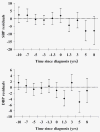Hypertension, hypercholesterolemia, diabetes, and risk of Parkinson disease
- PMID: 17761552
- PMCID: PMC2391077
- DOI: 10.1212/01.wnl.0000271883.45010.8a
Hypertension, hypercholesterolemia, diabetes, and risk of Parkinson disease
Abstract
Objective: To determine whether history of hypertension, hypercholesterolemia, or diabetes is associated with risk of Parkinson disease (PD).
Methods: Prospective study among participants in two large cohorts: the Nurses' Health Study (121,046 women) and the Health Professionals Follow-up Study (50,833 men). Mean duration of follow-up was 22.9 years in women, aged 30 to 55 years at baseline, and 12.6 years in men, aged 40 to 75 years at baseline. Relative risks (RRs) of PD were estimated from a Cox proportional hazards model adjusting for potential confounders.
Results: We identified a total of 530 incident cases of PD during the follow-up. Risk of PD was not associated with self-reported history of hypertension (RR = 0.96, 95% CI = 0.80 to 1.15), high cholesterol (RR = 0.98, 95% CI = 0.82 to 1.19), or diabetes (RR = 1.04, 95% CI = 0.74 to 1.46), after adjusting for age and smoking in pack-years. Risk of PD decreased modestly with increasing levels of self-reported total cholesterol (RR for a 50-mg/dL increase in total cholesterol = 0.86, 95% CI = 0.78 to 0.95, p for trend = 0.02), but use of cholesterol-lowering drugs was not associated with PD risk (RR comparing users with nonusers = 0.85, 95% CI = 0.59 to 1.23). Among individuals with PD, systolic blood pressure was similar to noncases up to the time of diagnosis but declined afterward.
Conclusions: Results of this large prospective study suggest that Parkinson disease risk is not significantly related to history of hypertension, hypercholesterolemia, or diabetes but may modestly decline with increasing blood cholesterol levels.
Conflict of interest statement
Figures

References
-
- Kannel WB, Sytkowski PA. Atherosclerosis risk factors. Pharmacol Ther. 1987;32:207–235. - PubMed
-
- Boysen G, Nyboe J, Appleyard M, et al. Stroke incidence and risk factors for stroke in Copenhagen, Denmark. Stroke. 1988;19:1345–1353. - PubMed
-
- Whitmer RA, Sidney S, Selby J, Johnston SC, Yaffe K. Midlife cardiovascular risk factors and risk of dementia in late life. Neurology. 2005;64:277–281. - PubMed
-
- Tan EK, Tan C, Fook-Chong SM, et al. Dose-dependent protective effect of coffee, tea, and smoking in Parkinson’s disease: a study in ethnic Chinese. J Neurol Sci. 2003;216:163–167. - PubMed
Publication types
MeSH terms
Grants and funding
LinkOut - more resources
Full Text Sources
Medical
